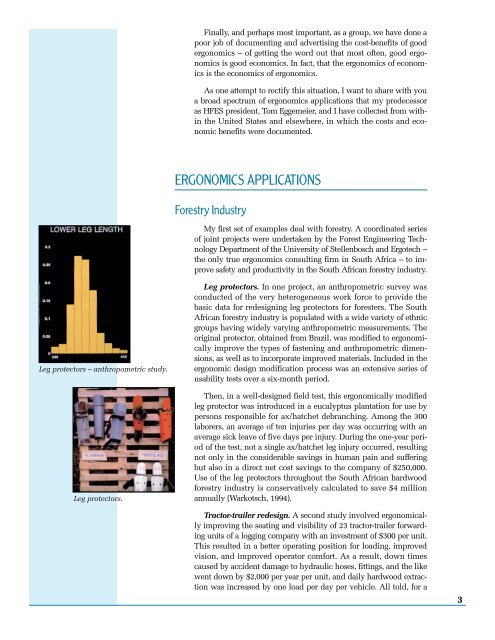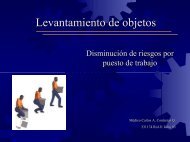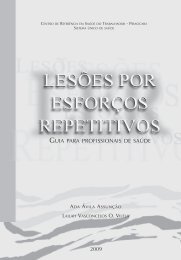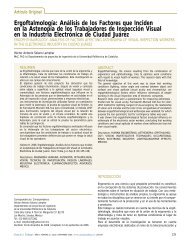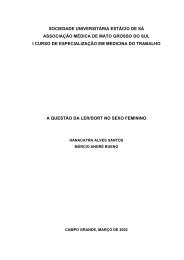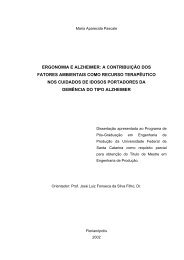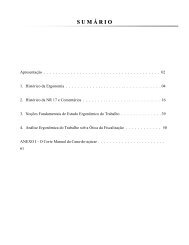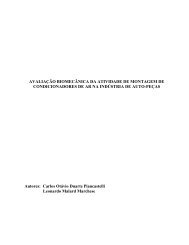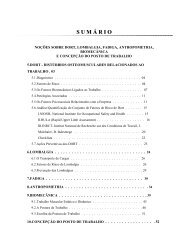Success Stories.12r5 - Human Factors and Ergonomics Society
Success Stories.12r5 - Human Factors and Ergonomics Society
Success Stories.12r5 - Human Factors and Ergonomics Society
Create successful ePaper yourself
Turn your PDF publications into a flip-book with our unique Google optimized e-Paper software.
Finally, <strong>and</strong> perhaps most important, as a group, we have done a<br />
poor job of documenting <strong>and</strong> advertising the cost-benefits of good<br />
ergonomics – of getting the word out that most often, good ergonomics<br />
is good economics. In fact, that the ergonomics of economics<br />
is the economics of ergonomics.<br />
As one attempt to rectify this situation, I want to share with you<br />
a broad spectrum of ergonomics applications that my predecessor<br />
as HFES president, Tom Eggemeier, <strong>and</strong> I have collected from within<br />
the United States <strong>and</strong> elsewhere, in which the costs <strong>and</strong> economic<br />
benefits were documented.<br />
ERGONOMICS APPLICATIONS<br />
Forestry Industry<br />
My first set of examples deal with forestry. A coordinated series<br />
of joint projects were undertaken by the Forest Engineering Technology<br />
Department of the University of Stellenbosch <strong>and</strong> Ergotech –<br />
the only true ergonomics consulting firm in South Africa – to improve<br />
safety <strong>and</strong> productivity in the South African forestry industry.<br />
Leg protectors – anthropometric study.<br />
Leg protectors.<br />
Leg protectors. In one project, an anthropometric survey was<br />
conducted of the very heterogeneous work force to provide the<br />
basic data for redesigning leg protectors for foresters. The South<br />
African forestry industry is populated with a wide variety of ethnic<br />
groups having widely varying anthropometric measurements. The<br />
original protector, obtained from Brazil, was modified to ergonomically<br />
improve the types of fastening <strong>and</strong> anthropometric dimensions,<br />
as well as to incorporate improved materials. Included in the<br />
ergonomic design modification process was an extensive series of<br />
usability tests over a six-month period.<br />
Then, in a well-designed field test, this ergonomically modified<br />
leg protector was introduced in a eucalyptus plantation for use by<br />
persons responsible for ax/hatchet debranching. Among the 300<br />
laborers, an average of ten injuries per day was occurring with an<br />
average sick leave of five days per injury. During the one-year period<br />
of the test, not a single ax/hatchet leg injury occurred, resulting<br />
not only in the considerable savings in human pain <strong>and</strong> suffering<br />
but also in a direct net cost savings to the company of $250,000.<br />
Use of the leg protectors throughout the South African hardwood<br />
forestry industry is conservatively calculated to save $4 million<br />
annually (Warkotsch, 1994).<br />
Tractor-trailer redesign. A second study involved ergonomically<br />
improving the seating <strong>and</strong> visibility of 23 tractor-trailer forwarding<br />
units of a logging company with an investment of $300 per unit.<br />
This resulted in a better operating position for loading, improved<br />
vision, <strong>and</strong> improved operator comfort. As a result, down times<br />
caused by accident damage to hydraulic hoses, fittings, <strong>and</strong> the like<br />
went down by $2,000 per year per unit, <strong>and</strong> daily hardwood extraction<br />
was increased by one load per day per vehicle. All told, for a<br />
3


